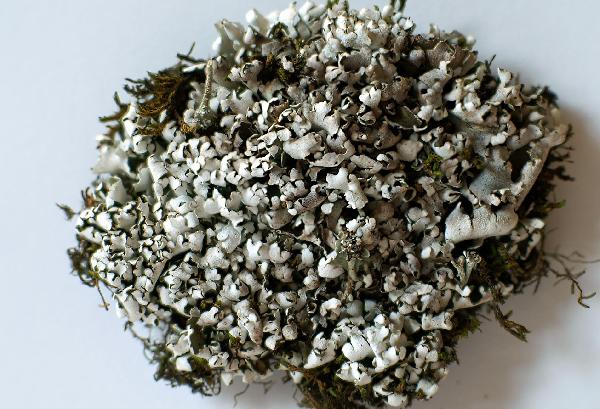Cladonia macrophyllodes Nyl.
Flora, 58: 447, 1875.
Synonyms:
Distribution: N - Frl (Tretiach & Hafellner 2000), Ven (TSB 7828), TAA (Nascimbene & al. 2022), Lomb (Valcuvia & al. 2003, Delucchi & Valcuvia 2004, Gheza 2019b, Gheza & al. 2022), Piem (Morisi & Sereno 1995), VA (Valcuvia 2000), Lig (Watson 2014). C - Sar (Nöske 2000). S - Cal (Puntillo 1996).
Description: Primary thallus squamulose, persistent, the squmules large, 8-15 mm long and (2-)4-10 mm broad, lobate to incised, concave to involute, glaucous green and verruculose above, white beneath, the basal parts yellowish to strongly melanotic. Podetia rare, hollow inside, 6-10(-15) mm tall, 0.5-3(-4) mm thick, glaucous grey-green, melanotic at base, areolate-corticate with white ecorticate interspaces, the youngest parts slightly tomentose, with 2-7 mm wide, regular or centrally proliferating, funnel-shaped cups with sometimes squamulose margins. Apothecia rare, brown, convex, developing at the margins of cups. Asci 8-spored, clavate, thickened at apex, with a K/I+ blue tholus and a K/I+ strongly blue outer gelatinous sheath, Cladonia-type. Ascospores 1-celled, hyaline, ellipsoid. Pycnidia dark, pyriform, often stalked, developing along the margins of cups or on the primary squamules, with a colourless jelly. Conidia hyaline, curved. Photobiont chlorococcoid. Spot tests: K+ yellow sometimes slowly turning brownish, C-, KC-, P+ red, UV-. Chemistry: atranorin and substances of the fumarprotocetraric acid complex.Note: an arctic-alpine, circumpolar species found on soil in open sites with a long snow-lie, optimum in the Alpine belt of the siliceous Alps. The record from Sardinia, overlooked by Nimis (1993: 237), is from Nimis & Poelt (1987: 86).
Growth form: Fruticose
Substrata: soil, terricolous mosses, and plant debris
Photobiont: green algae other than Trentepohlia
Reproductive strategy: mainly sexual
Commonnes-rarity: (info)
Alpine belt: rather common
Subalpine belt: rare
Oromediterranean belt: extremely rare
Montane belt: absent
Submediterranean belt: absent
Padanian area: absent
Humid submediterranean belt: absent
Humid mediterranean belt: absent
Dry mediterranean belt: absent

Predictive model
Herbarium samples
Growth form: Fruticose
Substrata: soil, terricolous mosses, and plant debris
Photobiont: green algae other than Trentepohlia
Reproductive strategy: mainly sexual
Commonnes-rarity: (info)
Alpine belt: rather common
Subalpine belt: rare
Oromediterranean belt: extremely rare
Montane belt: absent
Submediterranean belt: absent
Padanian area: absent
Humid submediterranean belt: absent
Humid mediterranean belt: absent
Dry mediterranean belt: absent

Predictive model
| Herbarium samples |
 INDEX FUNGORUM
INDEX FUNGORUM
 GBIF
GBIF
 DOLICHENS
DOLICHENS








